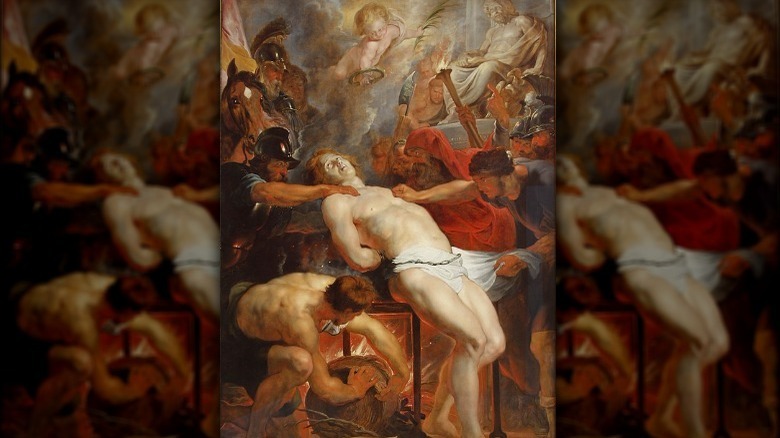This Small Italian Province Plays Host To A Bloody, Centuries-Old 'Miracle'
The nation of Italy has preserved countless facets of its archaic and historical grandeur. According to Capa World, celebrations like the Florentine New Year, feast days of patron saints, Epiphany, and the Festa della Rificolana — Festival of Lanterns, in honor of Mary, the mother of Jesus — have been around for centuries. If you've ever experienced the illustrious and frequently religious display of its architecture and culture, you're definitely no stranger to the region's timeless beauty.
CNN reports that one particular Italian festival that takes place every August is intended to pay homage to St. Lawrence, a deacon and martyr who, according to various accounts, was burned alive in the year A.D. 258 by order of the Emperor Valerian. For centuries, the townsfolk of Amaseno have carefully maintained a relic of the martyred saint's life that is the focal point of the annual festival designed to honor him. It's not a crucifix, nor a rosary, nor an article of clothing; according to Amaseno Online, the memento in question is actually a small vial said to contain a small amount of St. Lawrence's blood.
The blood of St. Lawrence
"Even though we know very little of this relic, it is mentioned in the consecration act of our church dated 1177 as containing 'the blood and fat of St. Lawrence,' and a 17th-century letter to the pope stated that people had realized that regularly around August 10 the blood would liquefy," says Don Italo Cardarilli, the priest who presides over Amaseno — a town which, until 1872, was known as San Lorenzo — St. Lawrence. Apparently, between August 8 and August 13 of each year, what's said to be the blood of St. Lawrence, preserved in a small glass vial for centuries, liquefies into a murky, scarlet substance, though experts have posed alternative possibilities as to what it might really be (via CNN).
All the same, the town of Ameseno heralds the phenomenon as a miracle and hosts its very own festival on St. Lawrence's behalf. While the blood may change its state of matter at any point throughout that particular week, August 10 is the day that's the focal point of the celebration. Throughout the rest of the year, the substance is kept safe in St. Mary Church and presented publicly on special occasions; visitors can also request permission to view the vial, says CNN. According to Amaseno Online, the blood is believed to have arrived in the town in the year 1177 and has remained there ever since; it was even delivered to the church with what was said to be a certificate of authenticity.
Is it miraculous?
While scientists have taken a vested interest in the blood of St. Lawrence over the years, none have ever removed it from the vial for fear of damaging it. However, some have carried out their own manner of detached experimentation on the substance that is said to be the stuff of miracles. "I spent days in Amaseno to analyze the behavior of the red liquid," says chemist Luigi Garlaschelli. "When I placed the flask inside a cold water container with ice it solidified, then I warmed it with a hair dryer at a temperature of 31 degrees Celsius (88 Fahrenheit) and it melted. It was indisputable proof." Garlaschelli believes that the contents of the vial are actually composed of wax, animal fats, red dye, and/or oil solubles and postulates that blood doesn't melt and harden over and over again like that (per CNN).
Rather, blood is apt to coagulate and dry up shortly after leaving the body, as CNN reports. Ergo, there's a chance that the blood of St. Lawrence isn't blood at all, but that possibility certainly hasn't hindered Amaseno's enthusiasm for their annual summer feast. Science, or faith? "You either accept it as a divine sign, through faith, without questioning it, or you don't. That's what a miracle is," Amaseno resident Fabio Marzi declared.


